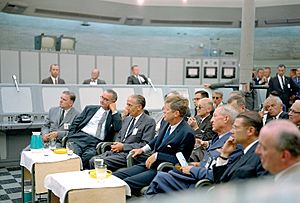Operation Paperclip facts for kids

Operation Paperclip was a secret program run by the United States. After World War II ended in Europe (between 1945 and 1959), the U.S. brought over 1,600 German scientists, engineers, and technicians to work for their government. These experts came from Nazi Germany, which was Germany during the war.
This program was managed by the Joint Intelligence Objectives Agency (JIOA). Special agents from the U.S. Army's Counterintelligence Corps (CIC) did most of the work. Many of these German experts had been members of the Nazi Party, and some were even leaders.
The main reason for Operation Paperclip was to give the U.S. a military edge. This was during the Cold War with the Soviet Union and the exciting Space Race. The Soviet Union had a similar program. They moved over 2,200 German specialists, along with their families (more than 6,000 people in total), in one night in October 1946. This was called Operation Osoaviakhim.
In February 1945, the Supreme Headquarters Allied Expeditionary Force (SHAEF) created a group called T-Force. By June, T-Force had over 2,000 members. Their job was to find important German targets. They looked for things like new designs for tanks, V-2 rockets, and jet planes. They also searched for important scientists and industrial leaders.
As many German scientists were found in April, T-Force created a special section to manage and question them. This section set up a detention center called DUSTBIN. It was first in Paris and later at Kransberg Castle near Frankfurt.
On July 20, 1945, the U.S. Joint Chiefs of Staff (JCS) started the first secret recruitment program. It was called Operation Overcast. Its first goal was to help end the war with Japan faster. It also aimed to help with military research after the war. The German scientists' families gave the name "Overcast" to the housing camp where they stayed in Bavaria.
In late 1945, the JCS created the JIOA. This group oversaw Operation Overcast and later Operation Paperclip. Representatives from the army, navy, air force, and the State Department were part of the JIOA. In November 1945, U.S. Army officers renamed Operation Overcast to Operation Paperclip. They would attach a paperclip to the folders of rocket experts they wanted to hire in America.
On September 3, 1946, President Truman officially approved Operation Paperclip. He expanded the program to include 1,000 German scientists. They would be under "temporary military custody."
Contents
Amazing Discoveries and Inventions
Operation Paperclip brought many talented scientists to the U.S. Their work led to important advancements.
Rocket Science and Space Exploration
Wernher von Braun was a key scientist from Operation Paperclip. He was the main designer of the Saturn V rocket. This powerful rocket made it possible for humans to travel to the Moon.
Aircraft Design
Adolf Busemann was another important scientist. He developed the swept wing design for airplanes. This design greatly improved how planes performed at high speeds.
Key Scientists and Engineers
Many experts in different fields joined Operation Paperclip. Here are some of the most well-known:
- Aeronautics and Rocketry
- Hans Amtmann
- Herbert Axster
- Rudi Beichel
- Wernher von Braun
- Adolf Busemann
- Werner Dahm
- Konrad Dannenberg
- Kurt H. Debus
- Walter Dornberger - led the rocket program
- Krafft Arnold Ehricke
- Anton Flettner
- Anselm Franz
- Ernst Geissler
- Dieter Grau
- Heinz Haber
- Karl Heimburg
- Gerhard B. Heller
- Rudolf Hermann
- Sighard F. Hoerner
- Kurt Hohenemser
- Oscar Holderer
- Helmut Horn
- Walter Jacobi
- Siegfried Knemeyer
- Heinz-Hermann Koelle
- Alexander Lippisch - an aeronautical engineer
- Robert Lusser
- William Mrazek
- Hans Multhopp
- Hans von Ohain (designed German jet engines)
- Ludwig Roth
- Arthur Rudolph
- Martin Schilling
- Ernst Steinhoff
- Heinrich Struck
- Ernst Stuhlinger
- Bernhard Tessmann
- Adolf Thiel
- Georg von Tiesenhausen
- Richard Vogt
- Woldemar Voigt (designed the Messerschmitt P.1101)
- Herbert A. Wagner
- Georg Rickhey - director of the Mittelwerk factory
- Architecture
- Heinz Hilten and Hannes Luehrsen.
- Electronics - including guidance systems, radar and satellites
- Hans Fichtner
- Georg Goubau
- Walter Haeussermann
- Otto Heinrich Hirschler
- Hans Hollmann
- Helmut Hölzer
- Kurt Lehovec
- Fritz Mueller
- Johannes Plendl
- Fritz Karl Preikschat
- Eberhard Rees
- Gerhard Reisig
- Heinz Schlicke
- Othmar Stuetzer
- Hans K. Ziegler
- Material Science (high temperature)
- Klaus Scheufelen and Rudolf Schlidt.
- Medicine – including space medicine
- Theodor Benzinger, Konrad Johannes Karl Büttner, Fritz Laves, Richard Lindenberg, Ulrich Cameron Luft, Walter Schreiber, Hubertus Strughold, Hans Georg Clamann, and Erich Traub.
- Physics
- Gunter Guttein, Gerhard Schwesinger, Gottfried Wehner, Helmut Weickmann, and Friedwardt Winterberg.
- Chemistry and Chemical engineering
- Helmut Pichler, Leonard Alberts, Ernst Donath, Josef Guymer, Hans Schappert, Max Josenhaus, Kurt Bretschneider, Erich Frese.
See also
 In Spanish: Operación Paperclip para niños
In Spanish: Operación Paperclip para niños

